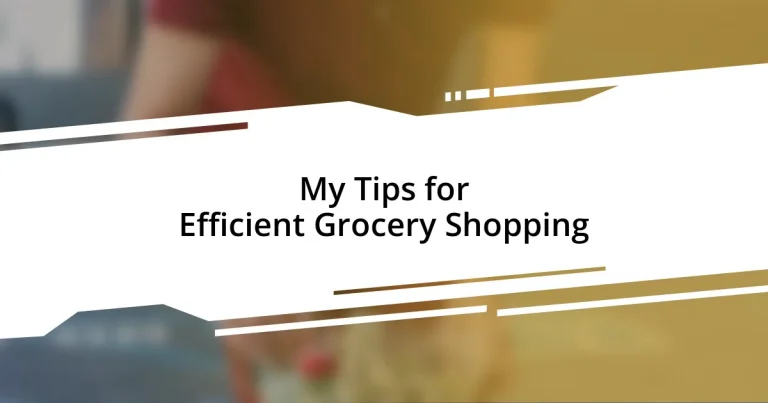Key takeaways:
- Track your meals for a week to understand eating habits and avoid unnecessary purchases.
- Create a dynamic grocery list categorized by store layout to save time and stick to a budget.
- Plan meals in advance to reduce stress, minimize food waste, and enhance family mealtimes.
- Utilize discounts and store loyalty programs to maximize savings while grocery shopping.

Understand Your Grocery Needs
Understanding your grocery needs is really about becoming aware of what you and your family genuinely eat and enjoy. When I started keeping track of our meals, I realized we were buying a lot of things that just ended up unused in the pantry. Have you ever found that half-eaten jar of specialty sauce that you bought on a whim? It’s such a waste!
I recommend taking a week to jot down what you cook and eat regularly. This simple practice not only highlights your staples but also helps you notice any patterns or preferences. Personally, I was surprised to find out that we often skipped fresh fruits during the week. Now, I always ensure to stock up on bananas and apples, knowing they’ll be devoured rather than left to go bad.
Also, consider mapping out your grocery needs around your life. For instance, if I know I have a busy week ahead, I make sure to pick up quick, versatile meals and snacks. This tailored approach can really minimize last-minute cravings and impulsive buys. Don’t you feel better when your shopping list reflects your lifestyle?

Create a Grocery List
Creating a grocery list is one of the most valuable habits I’ve developed over time. Initially, I used to go into a store without a clear plan, which often ended with me wandering the aisles aimlessly. I now take the time to compile a list before heading out, which not only saves time but also helps me stick to my budget. Have you noticed how easy it is to get distracted by flashy displays when you don’t have a list?
I find it beneficial to categorize items on my list based on the layout of the store. For example, I group all produce together, followed by dairy, then canned goods, and so on. This not only streamlines my shopping experience but also prevents me from backtracking when I remember a missed item. It feels much more efficient to glide through the store, checking items off my list, rather than running around in a frenzy.
Keeping your list dynamic is also key! I often review and update my grocery list on my phone as I run out of items during the week. I’ve found that having quick access to my grocery list right at my fingertips makes it much easier to remember what I need to pick up. This way, I can ensure a well-stocked pantry without any panic purchases!
| Benefits of a Grocery List | Consequences of No List |
|---|---|
| Helps manage budget effectively | Overspending and impulse buys |
| Streamlines shopping experience | Time wasted wandering aisles |
| Ensures you remember essential items | Forgetting important ingredients |

Plan Meals in Advance
Planning meals in advance has been a game changer for me. It transforms grocery shopping from a chaotic chore into a thoughtful, intentional routine. I’ve found that when I take a little time each week to map out our meals, it not only reduces stress but also makes my shopping trips feel so much more productive. For instance, on weeks when I plan dishes around what I already have in my freezer, I’m amazed at how little I need to buy, and it feels great to avoid food waste.
Here’s how I break down meal planning:
- Sit down once a week: I usually do this on Sunday mornings with a cup of coffee.
- Choose a variety of meals: I make sure to include at least one favorite dish for everyone in the family.
- Write down the ingredients: This way, I can easily cross-reference what I need on my grocery list.
- Adjust for the unexpected: Life can be unpredictable, so I always have a couple of flexible recipes ready that can be made with basics.
- Include snacks or quick meals: I find that having easy options on hand minimizes the temptation to grab fast food during busy nights.
When I started doing this regularly, I noticed how much more cohesive our mealtimes became. Not only do we eat healthier, but I also treasure those evening dinners—sitting around the table together, enjoying the meals I’ve planned with love. It has turned grocery shopping and cooking into not just tasks, but little moments of connection for our family.

Organize Your Shopping Route
Organizing your shopping route can transform an overwhelming task into a breeze. I’ve made it a habit to mentally walk through the store before I set foot inside. I remember the first time I tried this; I was amazed at how much time I saved. Instead of zigzagging through aisles, I followed a logical path that allowed me to gather everything efficiently. Could you imagine how much stress could vanish just by having a game plan?
When I think about my route, I always start with fresh produce, then move on to dairy, followed by pantry items. This systematic approach not only makes me feel accomplished, but it also keeps my energy up. I vividly recall a trip where I was incredibly hungry; not having a planned route meant more distractions and temptation at every corner. That trip ended with a few extra snacks that I didn’t need, which I learned to avoid on future outings.
Sometimes, I jot down store landmarks on my grocery list—like the location of that scrumptious almond butter or the bakery section. It’s like a treasure map specific to my favorite grocery store! This little detail keeps me focused and on track, minimizing that subtle urge to browse just for the sake of it. Have you ever found yourself lost in the cereal aisle? I know I have! Organizing my shopping route is not just about efficiency; it’s about enjoying my time at the store and avoiding unnecessary wanderings.

Use Budgeting Tips
Using budgeting tips can truly reshape the way you approach grocery shopping. I started meticulously tracking my expenses, and it was eye-opening. By setting a weekly budget, I became more mindful of my purchases and started to prioritize what we really needed versus what was merely tempting me at the store. Can you relate to that rush of excitement when encountering new snack options, only to realize you have no idea what you’ll actually use them for? This mentality shift allows me to walk out of the store feeling accomplished rather than guilty.
Another effective strategy I’ve adopted is creating a grocery list based on our meal plan and sticking to it. The first few times I did this, it felt almost restrictive, but I quickly learned it saved me money. I recall a shopping trip where I deviated from my list; I added a couple of impulse buys, and by the time I reached the register, my total was way above budget. That day taught me that those small, spontaneous purchases can really add up. Now, I treat my grocery list like a compass that keeps me focused on our health and finances at the same time.
Lastly, I’ve found value in utilizing coupons and app discounts. I never used to consider this, thinking it was only for the super-budget-conscious, but now I actively look for deals. I remember discovering a coupon for a brand I already planned to buy—what a thrill it was! That little win not only put a smile on my face but reinforced the idea that being strategic about finances can actually be fun. Have you tried using coupons lately? They could genuinely be the key to stretching your grocery budget further.

Take Advantage of Discounts
Taking advantage of discounts has transformed my grocery shopping experience in ways I never anticipated. Recently, I stumbled upon a store loyalty program that offered me exclusive discounts on items I regularly buy. It felt like a secret club where I reaped the benefits just for being a consistent shopper! Have you ever found yourself hesitating about joining a loyalty program? Trust me, it’s worth exploring—they often provide savings that can make a substantial difference in your monthly expenses.
One of my favorite tricks is to combine store specials with coupons for double the savings. Imagine my delight when I picked up a jar of my favorite pasta sauce that was already on sale, and on top of that, I had a coupon tucked away in my wallet. I can still recall the little rush of excitement I felt at checkout as I watched that total decrease. It’s like uncovering hidden treasure, don’t you think? These moments affirm my decision to shop smartly and remind me that every bit counts.
I also find joy in stocking up during seasonal sales or holiday promotions. Last Thanksgiving, I purchased a bulk supply of canned pumpkin when it went for a steal. I made pies for weeks, and even now, I’m enjoying the fruits of that bargain. It’s moments like these that make me wonder—how often do we miss out on savings simply because we don’t plan ahead? Embracing a proactive approach to discounts has not only made grocery shopping more enjoyable for me but has also sparked a sense of adventure in hunting down the best deals.

Evaluate Your Shopping Habits
Evaluating your shopping habits feels like turning a mirror on yourself. Recently, I took the time to reflect on my tendencies while grocery shopping, and I discovered patterns I never realized I had. For instance, I noticed I often gravitated towards the same aisles, which led me to overlook new products or healthier options. Have you ever caught yourself automatically reaching for the same familiar items, even when you’re trying to branch out?
One pivotal moment for me was when I tracked the types of items I consistently bought. I came to recognize my impulse purchases, especially in the snack section, which had a way of undermining my carefully crafted grocery list. It was eye-opening! My initial reaction was a mix of frustration and amusement—how could I justify buying chips when I had fresh fruits at home? Realizing that I was caught in this cycle urged me to change my approach.
I also learned to assess my grocery shopping frequency. I used to shop more often, which not only consumed time but also tended to fill my cart with unnecessary items. By spacing out trips and planning my lists more effectively, I found that my shopping became not just quicker, but also purposeful. Have you ever thought about how your shopping schedule impacts what you bring home? It’s interesting how small adjustments in our routines can lead to significant improvements in our habits.














